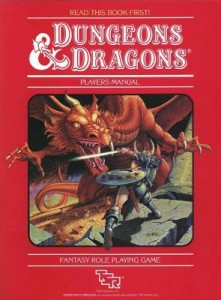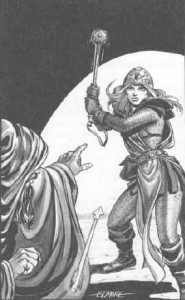The Legendary edition of Barbarians of Lemuria doesn’t come with a lot of creatures and most of them are pretty unique and unusual. Though my own goal with B/XoL is not to recreate Basic D&D but to take inspirations from it, Dungeons & Dragons is a great source when it comes to monsters. I think between BECMI and AD&D, there are way over a thousand of them.
Having looked at the creatures from the BoL Legendary Edition and the D&D Basic Set, I’ve come up with a couple of guidelines how to convert creatures from one game to the other:
Attributes: In the older editions of D&D, monsters don’t have any specified ability scores. However, starting with 3rd ed. they do, and the SRD is a good reference for them. Since the Lifeblood of monsters is not affected by their Strength score, we can simply ignore Constitution, and Wisdom always had almost no relevance to anyone but cleric, so we just need the Strength, Dexterity, Intelligence, and Charisma scores and convert them to Strength, Agility, Mind, and Appeal.
BoL says that an attribute score of 0 is human average, 3 is the maximum for new characters, and 4 or higher would be truly legendary. This is very convenient for us, as in D&D 10 is the average for humans and 18 the absolute maximum that only very few characters have. So we can simply make the conversion of 8=-1, 10=0, 12=1, 14=2, 16=3, 18=4, and so on. (Most animals would have a Mind attribute of -4, insects of -5. A Mind score of -3 is the minimum to understand languages and talk, if the creature is able to.)
Lifeblood: Having used some reference creatures that are pretty similar in D&D and BoL, I think the most practical formula to calculate the Lifeblood of a creature is simply 1 HD=5 LB. This is not modified by the creatures Strength score, as it would be for NPCs.
Protection: For protection, the different classes of armor can be used as reference. No meaningful protection = 0; fur or light hide = 1 (d3-1), thick hide = 2 (d6-2), scales = 3 (d6-1), thick scales = 4 (d6), extraordinary armor = 5 (d6+5).
Defense: Here it’s starting to get a bit fuzzy. Based on the creatures in the Legendary Edition, there are two hrd rules that are always obeyed: Defense is never lower than Agility, and never lower than 0. Other than that, there seems no consistent rules. Some creatures have an additional increase of Defense of +1 or +2, but that increase seems mostly arbitrary, though I think it’s somewhat more common with very powerful creatures than with weaker ones.
Initiative: The new Mythic Editon of BoL removes the Brawl combat ability and replaces it with Initiative. As I don’t have this edition I am not certain how it affects creature stats, but I would assume that in most cases Initative is simply identical to Agility.
Attacks: Here I have not been able to find any kind of consistent rules. The bonuses to attack and the amount to damage really seems to be entirely at the discretion of the gamemaster. There is only a single creature in the Legendary Edition that has a bonus of +5, and most are between +1 and +3. However, powerful characters can easily reach a Defense score of 7 (3 agility, 3 Defense, 1 shield), which means any attack needs a +4 bonus to have any chance to hit them at all. (And even then the chance is just 3%). So if you’re playing a campaign where characters reach that high Defense scores, feel free to give the bigger monsters attack bonuses of +6 and higher.
Damage: Damage appears to be more closely tied to the overall size and strength of the creature. 2d6 is already pretty high and only a few giant sea monsters get more than that. Since the Lifeblood of characters doesn’t really increase in BoL, I think it’s generally best not to go beyond this. If you want to make the monster nastier, make it hit more often instead.
A final thought that is currently bouncing around in my head is that one could potentially increase the average amount of treasure a creature has based on it’s Lifeblood (which with these conversions would be based on Hit Dice), but I think that may start to get too much into developing a full XP system, which I don’t really want to. My main motivation to add treasure to the game is to encourage the players to face monsters and dangers without a lethal fight during adventures. The search for treasure should not be the main reason to go on the adventure in the first place. I think that should still be motivated by some kind of basic background story. When Conan goes thieving, it’s usually not to get some bags of coins, but because he is looking for item specifically. But when you’re already in the place, why not make a few little detours to grab some bags with gold too?
 The first impression where so interesting that I thought about making this a series of post for other people like me, who really don’t know anything before 3rd Edition and perhaps a bit about AD&D.
The first impression where so interesting that I thought about making this a series of post for other people like me, who really don’t know anything before 3rd Edition and perhaps a bit about AD&D.
